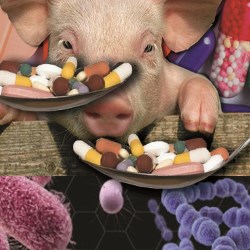Antimicrobial Resistance
 |
Antimicrobial resistance (AMR or AR) is the ability of a microbe to resist the effects of medication that once could successfully treat the microbe. The term antibiotic resistance (AR or ABR) is a subset of AMR, as it applies only to bacteria becoming resistant to antibiotics. Currently, at least 700,000 people die each year due to drug-resistant diseases, including 230,000 people who die from multidrug-resistant tuberculosis. More and more common diseases, including respiratory tract infections, sexually transmitted infections and urinary tract infections, are untreatable; life saving medical procedures are becoming much riskier, and our food systems are increasingly precarious. Research in Cambridge focuses on understanding the role of the animal-human interface in the development and spread of antimicrobial resistant pathogens, the use of whole genome sequencing to detect resistance genes, and trace the routes of transmission of multi-drug resistant organisms, such as MRSA, and identifying targets for new therapeutic agents. |
Cambridge groups and their work on Antimicrobial Resistance
Professor Mark Holmes Group (Department of Veterinary Medicine)
Dr Holme's research interests grew from a discovery by a PhD student in 2011 of a new strain of Methicillin Resistant Staphylococcus aureus (MRSA) that was undetectable using standard molecular methods. Since this discovery, the group have used whole genome sequencing to link two human cases of infection with this new strain of MRSA to farms in Denmark. Their findings raise questions about whether cows could be a reservoir for new strains of MRSA. Further work is now being undertaken to the prevalence and diversity of this previously undetectable new MRSA using whole genome sequencing and other techniques.
Whole genome sequencing has also been used to more immediate effect. In the Department of Medicine, the technology has been used to track and stop an outbreak of MRSA in a local special care baby unit. Researchers from the University of Cambridge, the Wellcome Trust Sanger Institute, and Cambridge University Hospitals used whole genome sequencing to confirm the presence of an ongoing outbreak of MRSA in a Special Care Baby Unit in real time. The team found that the outbreak had extended into the wider community, a conclusion that could not be reached with available methods. They also used sequencing to link the outbreak to an unsuspecting carrier, who was treated to eradicate MRSA, removing the risk of further spread and effectively halting the outbreak. Efforts are now under way to apply this technology to other bacteria, including multidrug-resistant Gram-negative bacilli, a group that comprises some of the most pathogenic disease-causing bacteria. Research led by Professor Sharon Peacock is exploring how fast and accurate sequencing can be used to examine drug resistance in Mycobacterium tuberculosis.
Researchers are also investigating possible targets for therapy. A team based at the University of Cambridge’s Department of Pharmacology has been working to understand the processes by which multidrug transporters deflect and eject substances from cells. These so-called ‘multidrug transporters’ are essential defence systems in all organisms ranging from bacteria to humans. They prevent the entry into the cell of toxic substances that are produced by our bodies or released by microorganisms competing for space and nutrients. By investigating the mechanism of molecular shape-shifting of a multidrug transporter that uses the energy-carrying molecule ATP (adenosine triphosphate), Dr Hendrik van Veen and colleagues have unearthed potential targets for therapy.
Another approach being taken in the Department of Biochemistry aims to target the ‘conversations’ that bacteria have with one another. Bacteria, like a good army, know that there is strength in numbers, and will hold fire until sufficient troops are present for a successful attack, when they can release e.g. toxins to overwhelm defence immune systems. They do so by ‘talking’ to each other, or ‘quorum sensing’, whereby each cell releases a molecular signal – the concentration of which informs them of the number of fellow microbes present, and whether there are enough of them to attack. This mechanism in controlling the bacterial attack makes it a promising target for therapeutic strategies – interfering with the quorum sensing mechanisms could minimise the destruction of the attacking forces. The approach, being taken by a collaboration between Dr David Spring in the Department of Chemistry and Dr Martin Welch and Prof George Salmond in the Department of Biochemistry is to interfere with the quorum sensing process by triggering the ‘attack’ signal when the bacteria are still at low number, allowing the immune system the opportunity to clear the infection while it is still in its infancy. Since the system is not essential for survival, it is less likely to provoke the development of resistance by the invading bacteria.
Antimicrobial Resistance Research News
AI 'scientist' finds that toothpaste ingredient may help fight drug-resistant malaria (18 Jan 2018)

